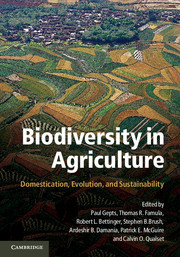Book contents
- Frontmatter
- Contents
- Tables
- Figures
- Foreword
- Contributors
- Acknowledgments
- Introduction: The Domestication of Plants and Animals: Ten Unanswered Questions
- 1 The Local Origins of Domestication
- Section I Early Steps in Agricultural Domestication
- Section II Domestication of Animals and Impacts on Humans
- Section III Issues in Plant Domestication
- Section IV Traditional Management of Biodiversity
- Section V Uses of Biodiversity and New and Future Domestications
- 22 Participatory Domestication of Indigenous Fruit and Nut Trees: New Crops for Sustainable Agriculture in Developing Countries
- 23 The Introduction and Dispersal of Vitis vinifera into California: A Case Study of the Interaction of People, Plants, Economics, and Environment
- 24 Genetic Resources of Yeast and Other Micro-Organisms
- 25 Biodiversity of Native Bees and Crop Pollination with Emphasis on California
- 26 Aquaculture, the Next Wave of Domestication
- 27 Genetic Sustainability and Biodiversity: Challenges to the California Dairy Industry
- Index
- References
27 - Genetic Sustainability and Biodiversity: Challenges to the California Dairy Industry
Published online by Cambridge University Press: 05 June 2012
- Frontmatter
- Contents
- Tables
- Figures
- Foreword
- Contributors
- Acknowledgments
- Introduction: The Domestication of Plants and Animals: Ten Unanswered Questions
- 1 The Local Origins of Domestication
- Section I Early Steps in Agricultural Domestication
- Section II Domestication of Animals and Impacts on Humans
- Section III Issues in Plant Domestication
- Section IV Traditional Management of Biodiversity
- Section V Uses of Biodiversity and New and Future Domestications
- 22 Participatory Domestication of Indigenous Fruit and Nut Trees: New Crops for Sustainable Agriculture in Developing Countries
- 23 The Introduction and Dispersal of Vitis vinifera into California: A Case Study of the Interaction of People, Plants, Economics, and Environment
- 24 Genetic Resources of Yeast and Other Micro-Organisms
- 25 Biodiversity of Native Bees and Crop Pollination with Emphasis on California
- 26 Aquaculture, the Next Wave of Domestication
- 27 Genetic Sustainability and Biodiversity: Challenges to the California Dairy Industry
- Index
- References
Summary
Issues and challenges related to the California dairy industry are examined in this chapter. This industry is a prime example of a very productive animal production system that has rapidly evolved in the Central Valley of California. The Central Valley, with its favorable climate, expanse of land for crop production, and proximity to agricultural byproducts that are fed to cattle, has favored the enormous success of this industry. However, there are many challenges facing California dairy productivity that will need to be addressed in the near future. The focus of this discussion will be on issues related to production efficiency, biodiversity, and breeding in the dairy animal population.
Overview of the California dairy industry
California has been the USA's leading dairy state since 1993 (CDFA 2007a). As shown in Figure 27.1, from 1950 to 2007 milk production has increased 580%, topping 40 billion pounds of milk in 2007, which constitutes 24% of the USA dairy supply. The number of animals has increased 130% to 1.8 million milking cows, while the number of dairies has gone down 80%, resulting in large production units averaging 600 cows, with some in excess of 3,000 cows (CDFA 2007a). The productivity of this industry exemplifies a large-scale animal production system (CAST 1999) that has taken advantage of scale economies to reduce cost of production, processing, and marketing, and over the past few decades, the industry has enjoyed very good economic times. The large production of milk has positioned California as a primary exporter of dairy products. Dairy products rank as the third largest agricultural export of the State of California with a value of US$604 million in 2006 (CDFA 2007b). Butter, nonfat powder, and cheese account for 77% of the milk product (Dairy Marketing Branch 2007), playing a major role in how the industry transforms the abundant supply of milk into exportable commodities. The production of cheese has propelled the growth of the industry, increasing 648% in the past 23 years from 305 million pounds in 1984 to 2.3 billion pounds, accounting for 47% of the milk in 2007 (Dairy Marketing Branch 2007).
- Type
- Chapter
- Information
- Biodiversity in AgricultureDomestication, Evolution, and Sustainability, pp. 549 - 561Publisher: Cambridge University PressPrint publication year: 2012



